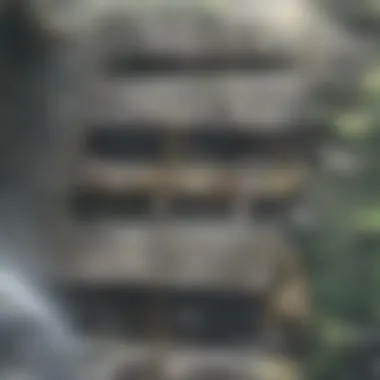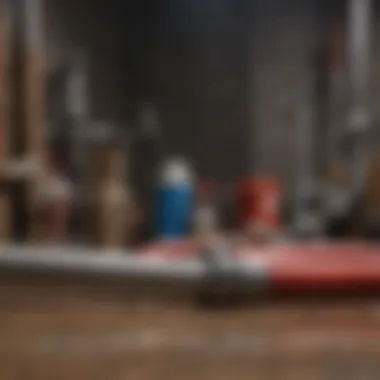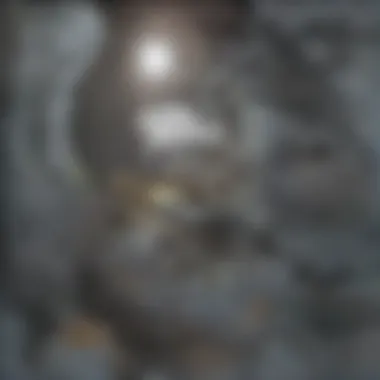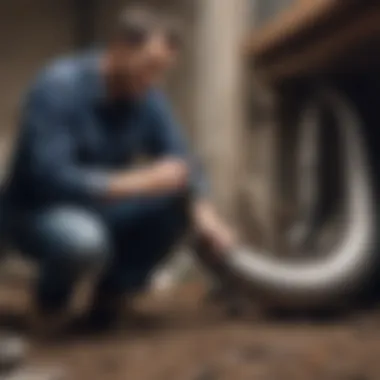How to Clear Waste Pipe Blockage: A Comprehensive Guide


Intro
Clearing waste pipe blockages is a common yet pivotal maintenance task for homeowners. Understanding the methods available not only simplifies the process but can also save time and expenses. Blockages can arise from various causes, including the accumulation of grease, hair, food particles, or foreign objects. This guide focuses on practical approaches for identifying and addressing these issues.
By equipping oneself with effective tools and techniques, one can tackle problems proactively. Furthermore, recognizing when to seek professional assistance is equally important. This will ensure that the plumbing system remains functional and efficient.
Causes of Blockages
Before jumping into solutions, it's essential to understand the root causes of waste pipe blockages. Here are some common culprits:
- Grease Buildup: Fats and oils can solidify over time, creating significant clogs.
- Hair Accumulation: Long strands can easily trap debris, leading to restricted flow.
- Food Waste: Even with a garbage disposal, improper disposal methods can lead to blockages.
- Foreign Objects: Items mistakenly flushed down the toilet or washed down the sink can create serious blockages.
Identifying the specific cause can help in determining the appropriate clearing method.
Tools and Materials Needed
A variety of tools can facilitate the clearing process. Having the right equipment on hand can make the task easier and more efficient. Here are some recommended tools:
- Plunger: Essential for loosening clogs caused by minor blockages.
- Drain Snake: Effective for dislodging debris further down the pipe.
- Wet/Dry Vacuum: Useful for sucking out blockages without damaging pipes.
- Chemical Cleaners: While effective in certain situations, these should be used sparingly to avoid pipe damage.
Methods to Clear Blockages
Several methods can be employed to address waste pipe blockages. Here are some effective techniques:
- Using a Plunger:
- Employing a Drain Snake:
- Applying a Wet/Dry Vacuum:
- Using Chemical Cleaners:
- Ensure there is enough water in the basin to cover the plunger.
- Create a tight seal over the drain opening.
- Push down and pull up rapidly for several cycles.
- Insert the drain snake into the pipe until resistance is felt.
- Rotate the handle to latch on to the blockage.
- Pull out the debris and repeat as necessary.
- Set the vacuum to liquid mode.
- Create a tight seal over the drain.
- Turn on the vacuum to suck out the clog.
- Follow the product instructions closely.
- Allow the chemical to sit for the recommended time before rinsing.
Preventative Measures
To reduce the risk of future blockages, implementing preventative strategies is key. Here are some simple tips to maintain clear pipes:
- Avoid pouring grease down the drain. Instead, dispose of it in a sealed container.
- Use a hair trap in showers and sinks to catch hair before it enters the pipe.
- Be mindful of what goes down the toilet. Only flush human waste and toilet paper.
- Regularly clean your drains with baking soda and vinegar.
When to Seek Professional Help
Despite best efforts, some blockages may require professional intervention. Signs that indicate it may be time to call a plumber include:
- Recurring blockages that resist home remedies.
- Foul odors coming from the drains.
- Multiple fixtures in the home showing signs of blockage.
The End
Understanding how to effectively clear waste pipe blockages can empower homeowners and improve their maintenance skills. By recognizing potential issues and responding with the right tools and techniques, it’s possible to maintain a functional plumbing system. This guide serves to inform and enlighten readers seeking practical solutions for their home maintenance challenges.
Understanding Waste Pipe Blockages
Waste pipe blockages can lead to unwanted complications in daily life. Understanding the nature and causes of these blockages is vital for maintaining clean and functional plumbing. Blockages often disrupt normal household routines. This section explores the definition, causes, and signs of waste pipe blockages, offering insights that will prove useful for both prevention and resolution.
Definition of Waste Pipe Blockage
A waste pipe blockage occurs when debris accumulation obstructs the normal flow of wastewater through the plumbing system. This can happen in residential or commercial properties and can lead to serious problems if left unresolved. The blockage can occur in any part of the drainage system, from kitchen sinks to bathroom pipes. Recognizing this definition is essential in pinpointing issues when they arise.
Common Causes of Blockages
Food debris


Blockages caused by food debris are common in kitchen sinks. When food particles are washed down the drain, they can accumulate over time. This is especially true for fibrous or starchy foods, which are notorious for sticking to the inner walls of pipes. Over time, these particles can form a sludge that prevents water from flowing freely. The key characteristic of food debris is its organic nature. It is a popular topic in drainage discussions because it represents a significant cause of blockages and is often the easiest to manage with proper disposal practices.
Grease buildup
Grease buildup is another frequent cause of waste pipe blockages. Many individuals pour fats and oils down the sink after cooking. These substances eventually cool and solidify within pipes, leading to constrictions that hinder water flow. Grease is particularly problematic because it bonds easily with other debris, compounding the blockage over time. This creates a challenging situation that can be hard to alleviate without dedicated cleaning efforts.
Hair accumulation
Hair accumulation often leads to clogs in bathroom drains. Hair strands can bind together, creating a dense obstruction that prevents water from draining effectively. The key feature of hair accumulation is its persistence, as hair does not decompose easily like food debris. This makes it an important focus area in waste pipe maintenance, particularly in households with long hair or regular grooming activities.
Foreign objects
Foreign objects present a more unpredictable blockage issue. Items like cotton swabs, small toys, or sanitary products can find their way into drains, leading to blockages that are often severe. The characteristic of foreign objects is their size and shape, which can greatly differ from typical waste. These objects make blockages harder to resolve, often requiring specialized tools or professional services for removal. The involvement of foreign objects complicates typical maintenance efforts, making it crucial to promote proper disposal practices.
Signs of a Blocked Waste Pipe
Slow draining
Slow draining is often the first noticeable sign of a blockage. Water may take an unusual amount of time to exit sinks or tubs. This characteristic makes slow draining a valuable early indicator for homeowners. Without immediate attention, slow drainage can lead to more severe complications.
Unpleasant odors
Unpleasant odors emanating from drains can signal a blockage as well. Food residue, hair, and other debris can decompose within the pipes, creating strong and unpleasant smells. This aspect of drain health should not be ignored. Taking action upon noticing these odors can help prevent more significant problems like pipe corrosion.
Gurgling sounds
Gurgling sounds in pipes often indicate air being trapped due to a blockage. This characteristic can be alarming, and it often warns of a buildup that may need attention. Gurgling typically occurs when other fixtures are being used, suggesting that the blockage could be more extensive than initially thought.
Overflow
Overflowing sinks, tubs, or toilets is a severe sign of blockage. It indicates that the water cannot pass through the waste system effectively and can lead to property damage if not addressed. Overflowing is the most serious indicator and requires immediate action to mitigate risks associated with flooding and contamination.
Regular awareness of these signs allows for timely intervention, making it easier to manage and resolve blockages effectively.
Tools and Materials Needed
The section on tools and materials is crucial to understanding the effective methods for clearing waste pipe blockages. Having the proper equipment not only enhances the success rate of clearing the blockage but also ensures the process is safe and efficient. Each tool serves a distinct purpose, which is why knowing which ones to use can save time and effort.
Basic Tools for Drain Clearing
Plunger
The plunger is a primary tool for clearing blockages in waste pipes. Its design typically features a rubber suction cup attached to a wooden or plastic handle. This tool creates pressure by pushing and pulling, making it effective for dislodging minor clogs. A key characteristic of a plunger is its simple mechanism, which requires no special skills to operate. Its popularity derives from being a cost-effective solution for many household clogs. However, it may not work well for more severe blockages.
Auger
An auger is another essential tool for clearing waste pipes. It consists of a flexible metal coil that can be inserted into the pipe to break up blockages. The unique feature of an auger is its ability to extend into long distances within the pipe, allowing it to reach obstructions that are otherwise inaccessible. It is often favored for larger clogs that a plunger cannot resolve. However, some may find it challenging to use without proper technique.
Drain Snake
The drain snake, similar to an auger, is designed for clearing deeper blockages. It is a long, flexible tool that can maneuver through bends and curves. The key characteristic of a drain snake is its effectiveness in reaching clogs further along the plumbing system. It is popular for household maintenance because of its versatility. However, users should be cautious while operating it, as excessive force can damage pipes.
Pipe Wrench
A pipe wrench is essential for loosening or tightening plumbing fittings. Its design includes serrated teeth that grip pipe surfaces securely. The pipe wrench is important when dealing with blocked pipes that may be interconnected with fittings needing adjustment. Its distinct feature is the adjustable mechanism, allowing it to accommodate various pipe sizes. A disadvantage is that improper use can lead to damage, so caution is necessary.
Household Items for Effective Solutions
Baking Soda and Vinegar
Baking soda and vinegar create a chemical reaction that can break down minor blockages. This combination works effectively as a natural cleaner. The key characteristic is that both items are commonly found in most households, thus providing an eco-friendly alternative to harsh chemicals. While it is usually safe and effective, it may not resolve severe clogs.
Hot Water


Hot water is a straightforward solution for clearing blockages caused by grease or soap buildup. The main aspect of using hot water is its ability to dissolve these substances, making it easier for them to flow down the pipe. It is beneficial because it requires no additional tools and is readily available. However, care should be taken not to use boiling water in plastic pipes, as it can cause damage.
Salt
Salt can be an effective agent when used with hot water, as it helps to break down thick clogs. Its key characteristic is its abrasive nature, which can aid in dislodging debris. Salt is often praised for its accessibility, as it is a common kitchen staple. However, relying on it alone may not yield significant results for stubborn blockages.
Safety Equipment
Gloves
Wearing gloves is essential for protecting hands during drain clearing. They keep hands safe from sharp objects and harmful substances in the waste pipe. The main characteristic of gloves is their ability to provide a barrier between the skin and potential hazards. They are a beneficial choice in this context since the job may involve exposure to unpleasant materials. One disadvantage is that gloves may hinder grip if they are not the right fit.
Safety Goggles
Safety goggles are important for preventing eye injuries when working with drains. They protect the eyes from splashes and debris that may occur when clearing a blockage. The key characteristic of safety goggles is the snug fit and full coverage they provide. They are a wise choice for anyone engaging in this work, as they offer a level of assurance against potential accidents. However, they may become uncomfortable if worn for extended periods.
Methods for Clearing Blockages
Understanding various methods to clear waste pipe blockages is crucial for maintaining effective plumbing in any environment. Different techniques address specific types of blockages. Being equipped with the appropriate methods can save time and resources. Consumers can benefit hugely from this guidance and avoid costly plumbing interventions.
Using a Plunger
Choosing the right type of plunger
When it comes to plungers, the type one selects is vital. There are mainly two types: the cup plunger and the flange plunger. The cup plunger is ideal for sinks, while the flange plunger is more effective for toilets. Its unique shape provides better sealing and blockage clearing. Choosing the right plunger helps create a proper seal, allowing for effective suction and pressure buildup. This leads to a better chance of dislodging the blockage.
Proper plunging technique
Utilizing proper plunging technique is fundamental for success. Position the plunger over the drain and apply even pressure. It is important to press down gently initially to avoid splashing. After the initial push, pull back forcefully. This repeated motion creates a vacuum effect, which can help in breaking down the clog. Mastering this technique can offer a simple and effective solution for minor blockages.
Employing a Drain Snake
How to insert the snake
Proper insertion of the drain snake is essential in tackling clogs. Begin by removing the drain cover to gain access. Slowly feed the snake into the pipe, turning it clockwise. This method allows the snake to navigate bends in the pipe efficiently. Ensuring smooth insertion reduces the chance of damaging the plumbing. Proper use increases the likelihood of removing even tough blockages with ease.
Clearing the blockage
Once the snake is inside the pipe, maneuver it carefully. Move it back and forth to help break apart the obstruction. If resistance is felt, it means the snake has caught onto the blockage. Carefully rotate the snake to latch onto the debris. This technique is beneficial as it allows for effective removal of material that might not be reached by other methods. While somewhat labor-intensive, the process can yield significant results.
Chemical Solutions
Using commercial drain cleaners
Commercial drain cleaners offer a quick and efficient way to tackle blockages. These products contain chemicals that break down organic matter within the pipes. The effectiveness of drain cleaners makes them a popular choice among homeowners. However, there are risks associated with their use, including potential pipe damage and environmental hazards. It’s crucial to follow the instructions for safe application.
Environmental considerations
Environmental considerations must not be overlooked when utilizing chemical solutions. Many drain cleaners contain harsh chemicals that can be detrimental to ecosystems when washed away. There are eco-friendly alternatives available that provide a gentler approach. Assessing the impact on the environment can help in making informed choices while addressing pipe blockages.
Hydro Jetting
Overview of the process
Hydro jetting is a method that uses high-pressure water to clear tough clogs. This technique can efficiently remove grease, sludge, and debris from pipes. It is an advanced method mainly used by professionals. Hydro jetting is especially favored when other methods prove ineffective. This comprehensive approach ensures that the pipes remain clean and less prone to future blockages.
When to consider this option
Hydro jetting should be considered in severe cases of blockage or when regular maintenance fails. It is also useful for homes with frequent clogs. Consulting a professional can determine the need for this service. While it can be a costlier option, the long-term benefits often outweigh the initial expense, making it a worthwhile consideration for homeowners.
Preventative Measures for Blockages
Preventing waste pipe blockages is essential for maintaining the integrity and efficiency of your plumbing system. Recognizing the significance of preventative actions can help you avoid costly repairs and ensure a smoother flow of wastewater. Effective preventative measures not only reduce the risk of blockages but also extend the life of your pipes. In this section, we will discuss the importance of regular maintenance, proper disposal practices, and installing drain screens.


Regular Maintenance
Routine cleaning practices
Routine cleaning practices play a vital role in preventing waste pipe blockages. Regularly cleaning your drains can help eliminate buildup before it becomes a significant problem. A key characteristic of these practices is their simplicity. For example, pouring boiling water down your drains can help dissolve grease and food particles. This is a beneficial choice because it requires minimal tools and can often be done quickly.
The unique feature of routine cleaning is its ability to address multiple issues without frequent specialized help. By performing these simple tasks, you can avoid serious clogs that might require professional intervention later. However, one disadvantage could be the need for consistency; skipping cleaning can lead to more severe blockages.
Scheduling professional inspections
Scheduling professional inspections is another crucial aspect of maintaining waste pipes. These inspections provide necessary expertise that can detect early signs of trouble. A significant characteristic of professional inspections is their thoroughness. Trained technicians can identify potential issues that an untrained eye might miss. This is especially beneficial because it helps address problems before they escalate into major blockages.
One unique aspect of scheduling such inspections is the use of advanced technology. For instance, professionals often utilize video inspection tools to evaluate the condition of pipes. This precision offers an advantage as it allows for targeted solutions. However, a downside may be the cost, which can be a consideration for some homeowners.
Proper Disposal Practices
Disposing of grease
Proper disposal of grease is critical for preventing waste pipe blockages. Grease can solidify in pipes, creating substantial blockages over time. A key characteristic of proper disposal is that it prevents buildup right from the source. It is a beneficial method as it requires changing simple habits, like using a container for grease instead of pouring it down the sink.
A unique feature of this practice is its long-term influence on plumbing health. By consistently disposing of grease correctly, you significantly reduce the chance of reoccurring blockages. The disadvantage may include the need for behavioral adjustments, which some may find difficult to integrate into their routine.
Hair management
Hair management is also a crucial aspect of preventing waste pipe blockages. Hair can easily accumulate in pipes and lead to significant blockages if not managed properly. One key characteristic of effective hair management is the use of preventive measures such as drain covers. These covers act as barriers, preventing hair from entering pipes. This makes it a beneficial approach, as it is often inexpensive and easy to implement.
The unique feature of hair management is its proactive stance. By preventing hair from entering pipes in the first place, you reduce the chance of future issues. However, a downside could be that some homeowners may overlook this simple step, thinking of it as an unnecessary measure, until a blockage occurs.
Installation of Drain Screens
Installing drain screens is one of the most effective preventative measures. These screens act as a first line of defense against debris entering the waste pipe system. They are beneficial because they capture hair, food particles, and other debris before it can cause significant blockages. The unique feature of drain screens is their simplicity in design yet effectiveness in function.
When to Call a Professional
Recognizing when to call a professional is crucial in addressing waste pipe blockages. Homeowners should be aware that some situations require expert intervention to prevent further damage. Ignoring serious issues can exacerbate plumbing problems. Here are key indicators that indicate professional help is necessary.
Indicators of Severe Blockage
Multiple drains affected
When multiple drains are affected, it indicates a systemic issue within the plumbing system. This situation often means that the main drainage line may be blocked. The significance of this aspect cannot be overstated; multiple drain blockages typically suggest that the issue is not isolated to just one area. A characteristic of this scenario is slow draining in different parts of the house. This can lead to backups and potential plumbing disasters. Understanding this aspect is beneficial because immediate action can minimize damage and cost. If you notice several drains are slow, it is a clear signal to contact a professional.
Foul odors persist
Foul odors that remain in the home are another strong indicator of a severe blockage. Such smells often arise from stagnant water or decomposing waste in pipes. The presence of persistent foul odors signals that a blockage may be causing sewage to back up, affecting the quality of air in your living space. This is concerning for health and safety. The unique feature of this situation lies in its immediacy; unpleasant smells prompt urgent action, necessitating a professional's expertise. In this article, recognizing foul odors as a clear signal can help prompt timely response to unresolved drain issues.
Benefits of Professional Services
Engaging professional plumbing services provides several advantages when dealing with waste pipe blockages. Firstly, experts have the necessary tools and expertise to diagnose issues accurately. They can identify underlying problems that may not be visible during a basic inspection. Moreover, professionals are equipped to handle hazardous materials safely, protecting both their health and that of the homeowner. Another benefit is that professional interventions often come with a service guarantee, ensuring that if the issue persists, it can be revisited without extra costs. Therefore, prioritizing professional help for severe blockages can save time, money, and stress, leading to a more effective resolution of plumbing problems.
Culmination
In any discussion surrounding waste pipe blockages, the conclusion serves as a pivotal element. It summarizes essential information, reinforces the significance of proactive measures, and offers final thoughts on addressing blockages effectively. This section should not merely restate what has been covered; it should provide clarity on the issues presented and highlight the benefits of understanding and managing waste pipe systems.
Clearing waste pipe blockages is not just about resolving immediate problems. It is about cultivating a deeper awareness of how waste systems operate, addressing potential issues before they escalate, and protecting the integrity of your plumbing. The insights gathered throughout this article are invaluable for anyone looking to maintain their home or deal with minor plumbing challenges independently.
"Understanding your plumbing system gives you the power to address it effectively."
Summary of Key Points
- Key Causes of Blockages: Food debris, grease buildup, hair, and foreign objects can clog waste pipes.
- Tools and Methods for Clearing: Familiarize yourself with plungers, drain snakes, and chemical solutions to handle typical blockages effectively.
- Preventative Measures: Regular maintenance, proper disposal of waste, and using drain screens can significantly reduce the risk of blockages.
- Professional Help: Recognizing when to call a professional is vital, especially in cases of severe blockages.
Addressing these points equips homeowners and maintenance enthusiasts with a practical framework for managing waste pipe issues.
Final Recommendations
- Routine Attentiveness: Regularly inspect and clean your pipes to mitigate the risk of blockages.
- Thoughtful Disposal Practices: Always dispose of materials properly and monitor what goes down the drain.
- Stay Informed: Educate yourself about plumbing systems; this can help prevent issues before they arise.
- Seek Professional Guidance: When in doubt, do not hesitate to consult a plumbing professional for advice or assistance.
By implementing these practices, maintaining waste pipes can become a manageable task, resulting in better plumbing health and minimizing the potential for urgent repairs.







